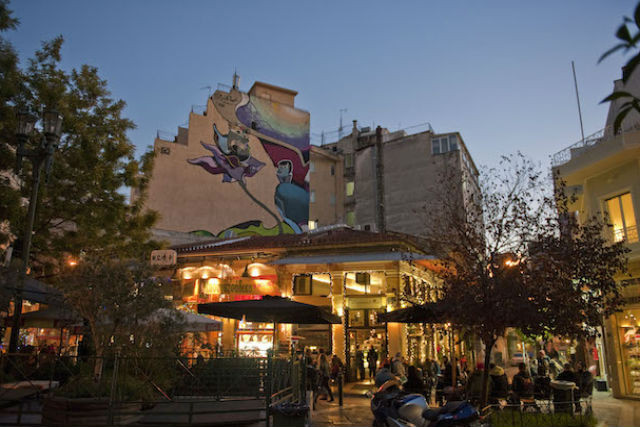Forget ancient Greece, there is nothing dead about Athens, or the “the eye of Greece”, where the festival of culture unfolds each summer, offering up a motley Meze of things to see and do.
Live street outdoor performances of opera, jazz, rock and folk provide a soundtrack for tourists strolling near the Acropolis late at the night. This intoxicating blend leaves its mark on visitors--couples are magnetically drawn to the quieter streets surrounding the ancient ruins. Meanwhile, revellers can easily lose track of the time in the cocktail and gin bars found in the buzzing Kerameikos or Psirri districts.
If some areas of the city look sad and dilapidated, do not be fooled. Greek innovators have turned abandoned spaces into hubs of activity such as furniture factory-cum-arts centre the Peiraios 260, in the Tavros district where visitors can catch a play during the festival. Stunning graffiti adorns many buildings in the city, providing a reason to don those walking shoes and follow your feet around the city.

Photo: Delano
Athens offers many interesting museums but if you want to skip the long queues, head for the Byzantine museum, pictured above, charting the evolution of this empire through art and iconography. Its green and shady garden offers a welcome retreat from the midday heat.
Tourism has always been the bread and butter of the Greek economy. But the financial crisis, and media coverage of migrants entering the country has dented the steady flow of tourists of the past. Today stakeholders are working on restoring and refining the country’s image, this time focusing on its gastronomy and wines. To gain an overview without walking too far, check out Yoleni’s Greek Gastronony Centre, pictured below, which opened in 2016 in the Kolonaki district.

Photo: Delano
Its tagline is that it is the destination to explore flavours from all corners of Greece and with over 20 different olive oils and scores of wines, capers, spices and other products which you can try during lunch or dinner time, it comes up good on its promise. The centre also offers cookery workshops and olive oil tasting and boasts a children’s playspace to enable parents to lose themselves in the experience.
Pistachio island
Greece has over 6,000 Islands and a trip wouldn’t be complete without a visit to one. The most accessible is Aegina, less than an hour’s ride away on the flying dolphin boats from Piraeus port. Popular with celebrities, many of which have a second home here, the island remains affordable for the budget tourist when it comes to eating out. Aegina is best known for its pistachio production, a plant which is not native but has become part of its identity with the pistachio festival taking place shortly after the annual harvest in September.
Many shops sell pistachios roasted or prepared in other ways. If you have time and the inclination, rent a bike or scooter and visit other parts of this tiny island such as the fishing village of Perdika. The temple of Aphaia, is a peaceful and well-maintained archaeological site that dates back 2,500 years and offers stunning 360° views. There are also numerous bathing spots along the coast, most public.

Photo: Delano. A shop on the island of Aegina
History & wine in the Attica peninsula
Another day trip from Athens or overnight stay is the Attica peninsula, south of Athens. Here, history buffs can visit the Temple of Poseidon, jutting out on a cliff edge on Cape Sounion. Watching the sunset over the Aegean from this viewing point is a highlight for many tourists.
Winelovers meanwhile, should not miss visiting Greece’s largest wine region, boasting 16,000 acres of vineyards. While many vineyards are a 30-minute drive from the capital, it is worth taking your time to see the curious squat vines, growing low to the ground to protect the fruit against the powerful Greek sun.

Photo: Y Skoulas. The Temple of Poseidon, jutting out on a cliff edge on Cape Sounion
Wine has been made in the area for thousands of years but many of the vineyards were destroyed by the phylloxera epidemic of the late nineteenth century. The industry returned and, while producers focused on cheap, mass production, the past decade has seen a shift to better quality and smaller yields.
Savatiano, pictured below, is the most popular grape variety grown in the region, a wine which pairs nicely with Greek cuisine. Most wine tastings are charged per head and should be booked in advance. The family-run Mylonas winery, is a good starting point. Alternatively, book a tour with an organisation like Vins Oenotourism Events.

Photo: Delano. Vines grow low to the ground in the Attica peninsula to protect the grapes from the heat
Flights & accommodation
Fly to Greece directly from Luxembourg with Aegean Airlines, with in and outbound flights each Friday and Tuesday until October.
The arty Grecotel Athena Pallas offers centrally located, boutique-style rooms decorated with graffiti motifs. If looking for a touch of luxury, head for the Grecotel Cape Sounio, a small village of exquisite villas overlooking the sea with indoor and outdoor pools and excellent catering and bar facilities. Both hotels offer family rooms and Cape Sounio even organises activities for children.
